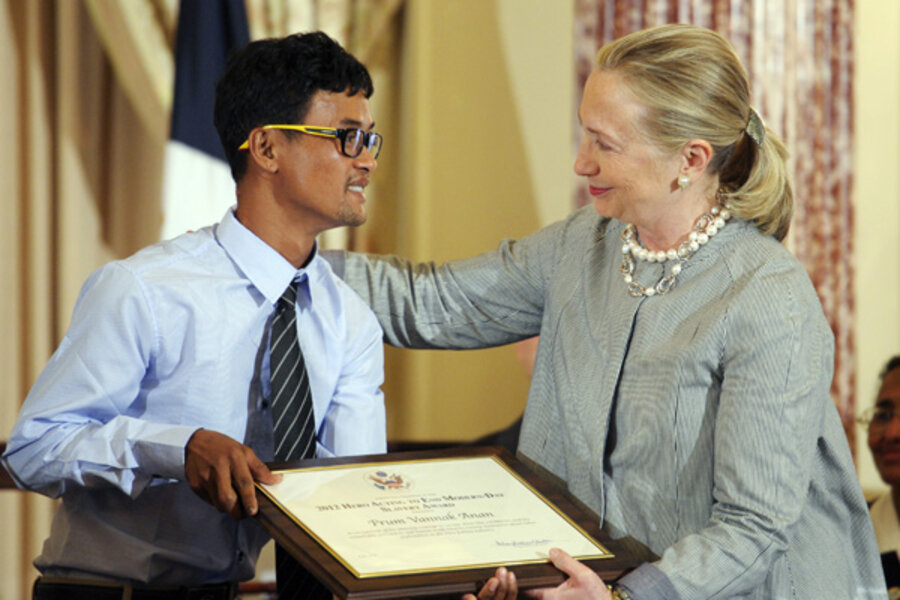How one man swam to freedom and into fight against modern-day slavery
Loading...
| Washington
In 2009, Cambodian Prom Vannak Anan dove into a dark sea and away from a life of beatings, unpaid labor and imprisonment on a fishing boat. The lights of a port, four miles distant, guided him. The desire to be free kept him swimming.
Anan had been a new father and husband in 2005 when a “job agent” offered him a path to a better life, then moved him far from home. Instead of a job, he was sold as a laborer to a Thai boat owner. For years, he endured physical and emotional pain, hoping for a chance to escape.
So around midnight in 2009, as the crew slept on a rare night when they anchored near enough to see the shore, he swam for freedom.
Instead of mercy, the Malaysian police he’d hoped would help sold him to a palm oil plantation. It took him another year – much of it in jail – to finally find help, freedom and a way back to his family.
On Tuesday, the State Department named Anan among 10 people who made a difference in fighting modern-day slavery worldwide. Releasing its annual global report on human trafficking, the department called these individuals heroes for combating the tragic trafficking in young children for the sex trade and the sale of adults, like Anan, who were trapped in lives of unpaid labor.
Ambassador Luis CdeBaca, who heads the State Department Office to Monitor and Combat Trafficking in Persons, said that publicizing stories like Anan’s could inspire others to help fight what he called a global epidemic. The numbers released Tuesday in the department’s annual Trafficking in Persons Report show that the tragedy of Anan’s story isn’t just that it is so horrible and so cruel, but that it is so common.
Worldwide, an estimated 27 million people live as slaves. For context, consider that in the pre-Civil War United States, the very open and public Southern slave population peaked at around 4 million. US officials say, in fact, that the world has never been home to more slaves than it is today.
The State Department report says that while slaves are held in captivity in places such as Cambodia and Malaysia and Thailand, they also can be found as forced hotel housekeepers, prostitutes or dishwashers in places such as Kansas City, Mo., Charlotte, N.C., and Sacramento, Calif.
“We’re seeing more prosecution, and more victims identified and freed, helped,” said CdeBaca. “But it’s a good trend. It means we’re finally learning the depth of the problem. As we collect better data, the numbers will continue to get worse for a couple years now, as more nations join the fight against human trafficking.”
But there is a long way to go, even in the United States. CdeBaca noted that Georgia passed an anti-human trafficking law just a year ago – and that not even a week passed before authorities filed their first charges under it.
Modern slavery exists because it is big business – a $30 billion a year industry, just about the size of the American milk industry. And experts agree that the problem is growing.
Gary Haugen, who heads the International Justice Mission, is another of the 10 heroes singled out by the State Department this year. His organization has helped thousands of victims and also worked to prosecute traffickers so that they can’t ensnare others. An example: Their 4-year-old program in Cebu in the Philippines has reduced child sex trafficking by 79 percent merely by convincing local law enforcement to enforce existing laws.
“There are 27 million slaves, so how many people get sent to jail for enslaving them?” Haugen asks. “The number is shamefully tiny compared to the size of the problem. . . . Human trafficking can only thrive with the complicity of local law enforcement.”
In some places, that can mean that police are part of the problem. In Malaysia, Anan was sold back into slavery by police. In the United States, that can mean that when a sex slave is swept up in a prostitution sting, the slave is treated like a criminal, not a victim, and the root cause of the problem is never examined.
The State Department suggests 20 ways people can aid in the fight. Some are as simple as making sure elected officials know voters care about eliminating modern-day slavery. Others include letting retailers know that customers expect a slavery-free supply chain. Parents should encourage schools to include lessons on the existence of modern slavery as a way to raise awareness throughout communities, the department says.
While officials say the situation is dire, they offer reasons for hope. One is Prom Vannak Anan. His life today is telling his stories, to motivate others to take a stand. He has recreated his ordeal in a series of drawings that anti-slavery activists hope to publish to raise awareness.
During a visit to Washington this week to accept his hero award from the State Department , in a mundane hotel lobby on a muggy afternoon, Anan proclaimed himself a lucky man. “How many people get chances such as this, to come to the United States, to be treated well,” he said.
The daughter he didn’t meet until he was free now waits for him to come home. He lives a simple life in his native Cambodia, but he spent years in bondage dreaming of such a simple life.
“I don’t know what the future holds, whether it will be black or white, good or bad,” he said in between sips of Coke. “I can’t know the future. But I do know that I will try hard. I wish to live a better life, a free life.”







